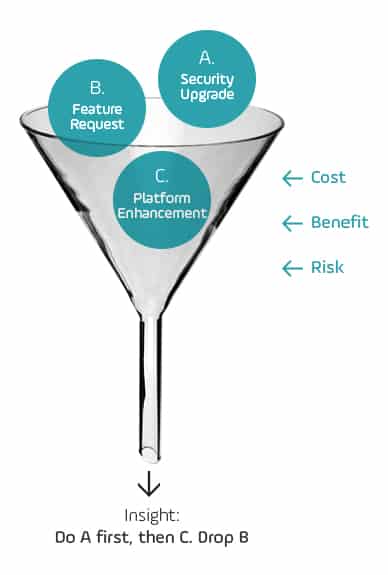Table of Content
Application Portfolio Program Management (AKA Project Portfolio Management, or PPM) is the methodology at the core of your IT application strategy. Portfolio Management is about the Big Picture view that sets the objective criteria for identifying, ranking, positioning and selecting new application and change delivery projects.
PPM has three elements that are critical to application delivery: Collaboration, ForeSight and Risk Management. Using the right tool, those elements can be integrated into the application delivery process.
How Does PPM Work?
PPM starts with the profiling of your organization’s business applications and all related change delivery projects and activities. This together with cost and risk analysis enables the evaluation of business value and technology fitness. The outcomes are insights that help you to identify and prioritize activities for improvement.
PPM technology helps organizations optimize capabilities for the resources available. It supports effective portfolio management with prioritization of activities based on their ROI. PPM also involves de-prioritizing low-value project and activities and deciding to sunset certain applications because they require too many upgrades or lack compatibility with newer applications.
Can Your Application Delivery Process Benefit From PPM?
Here are some of the high-probability indicators that your organization can benefit from PPM:
- No prioritization process for business requests
- Intense internal competition for financing and staffing of projects
- Third-party vendor costs seem to always spiral out of control
- Frequent changes to projects’ status (active, on-hold, priority etc.)
- Many projects do not add strategic value to the organization
- Too many small projects underway
- No available ‘knowledge base’ of lessons learned
- Projects benefits are not captured or tracked
- No accountability for projects’ success
- Project teams are overworked and underappreciated
- Excessive project delays due to lack of resources
The Value of PPM to Application Delivery
Business application delivery is really about delivering strategic value to your organization. Time-to-Market is critical and so, any program or project delay can incur costs due to the loss of business or market share to competition.
Consider this scenario, for example, you have committed to deliver a new standard (i.e, compliance), applicable to your entire Digital Transformation portfolio. To meet this strategic goal of readiness for a campaign or regulation, you have divided your team into smaller teams and assigned them to multiple parallel projects and applications. This is a complex operation and visibility into progress is critical. Real-time risk mitigation enables you to spot standard requirements that are being delayed and flag them as being at risk of failure to meet the release date.
Similarly, actionable insights are provided with regards to deviation from a planned program budget. Once a budget deviation is spotted, for example, on the estimated development and testing efforts, you as the program manager may take a decision to reduce the program scope, add more resources or extend the delivery timeline.
Finally, a PPM system can offer actionable program-based insights on overall risk of not meeting the release calendar quality gate KPIs. For example, a critical release KPI for this new standard is meeting 100% test coverage execution and ZERO defects. Your PPM solution can help you identify on-time, that critical defects were found within the regression cycle. You can then identify the exact project and epic owners, for a fast call-to-action. Next, use your PPM tool to have your developers and testers respond fast, fix it and test defects, within the set timeline. If your team is out of capacity to handle those, further actions can be applied, like allocating team members from other, less strategic projects, to meet the program release calendar.
To recap, done right, PPM can eliminate portfolio bloat, reduce complexity, overlap and redundancy. Employ PPM for better efficiency in the delivery of IT-enabled business services.
Why PPM Is Critical to Application Delivery
Releasing change to a business app has a ripple effect on other platforms and apps that is often associated with risks such as downtime or critical business errors.
The PPM process helps enterprises predict the outcome, avoid risks and plan for projects that will offer the best results. Smart decision making is about analyzing risk vs. reward. Here are some of the questions PPM can answer in relation to application change delivery:
- Is this change critical to our overall objectives as an organization?
- What current projects might act as a barrier to completing this change?
- Do I have the resources available to take on this change project?
- Is there a similar project in my portfolio I can use to model after this one?
- Are the stakeholder’s expectations realistic? Where can we compromise?
Project portfolio management and PPM tools help companies break down every detail of a proposed change project – budgets, resources, tasks, timelines and goals. Using in-depth analysis of proposed changes, weighed against current projects, a company can define what risks offer the most rewards.
Why Some Organizations Are Slow to Adopt PPM
Enterprises are slow to adopt PPM because getting the business to support applications’ change is difficult. Change delivery projects generally don’t get the opportunity to start unless a major business transformation initiative is forcing a reevaluation of the entire portfolio.
Some organizations will regularly manage at a business service level to avoid portfolio management, while others will try to get by with short-term management focused on service delivery. However, both approaches would most likely fail to identify applications or services as they come to the end of their useful life.
The 3 PPM Elements That Are Critical to Application Delivery
Multiple vendors currently offer portfolio management solutions. The key factors to look at when choosing a PPM solution are collaboration, foresight and risk management.
Collaboration
With an optimal PPM solution, all stakeholders are kept in the loop with reliable and consistent feedback. Business executives should know what project managers to engage, project managers should gain easy access to team members and team members improve communication with leadership.
ForeSight
A winning portfolio management solution would present real-time information on the risk associated with every requirement and project. It would help prioritize transformative initiatives over low-ROI ones and eliminated functional redundancies.
Risk Management
Using unique key indicators that illustrate risk (e.g., costs versus returns), a winning PPM tool can apply a tough go-or-kill decision point to determine whether a project should go forward. This allows for the creation of fluid and replicable workflows that ensure efficiency and optimal team performance.
A Final Word on Features
When selecting a PPM solution, seek out these must-have features:
- Central management of projects, releases and future Business and IT demand
- Insights on activities, past and future investments, across all applications and business areas
- Drag-and-drop dashboard for project creation, requirement assignment and release scheduling
- Out-of-the-box progress and risk dashboards monitor project planning and execution status

